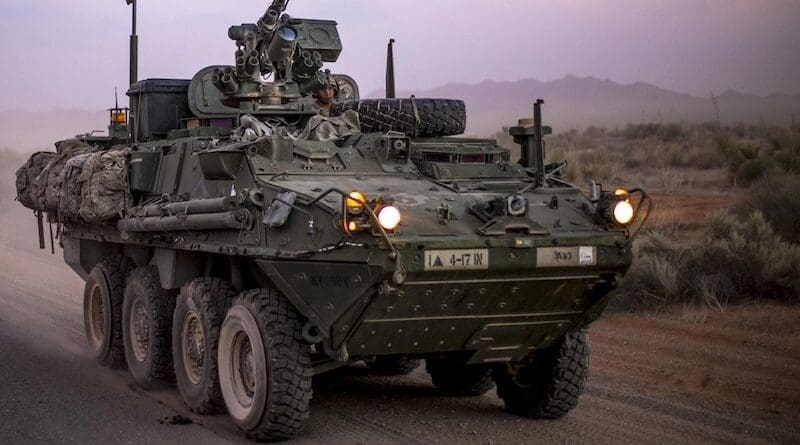From Battlefield To Factory Floor: India And USA Collaborate On American Stryker Production – OpEd
India and the United States are in advanced talks to jointly produce the latest generation of Stryker armoured infantry combat vehicles. This effort is part of a larger plan for defence-industrial cooperation. Recently, the US offered to show the mobility and firepower of the Stryker in high-altitude areas of India. First Post quotes The Times of India as saying that the Indian defence ministry is looking into a three-phase plan for this project.
The project will, initially, purchase a limited, off-the-shelf consignment of Strykers through the US Foreign Military Sales (FMS) programme. After that, there will be joint production in India and, eventually, they will co-develop advanced versions of the vehicle, the First Post report adds.
The entire plan depends on the Stryker meeting the operational needs of the Indian Army’s mechanized infantry units and achieving a high level of local production. This includes transfering important technologies to the Indian co-production partner, which could be a defence public sector undertaking (PSU), or a private company.
The Indian Army needs a large number of advanced wheeled and tracked infantry combat vehicles (ICVs) to replace its current fleet of over 2,000 Russian-made BMP-II vehicles in the next few years. The Ministry of Defence (MoD) is also working on indigenous projects to meet this demand.
The US is actively promoting the Stryker vehicles. Before US National Security Adviser Jake Sullivan’s visit to India, US Secretary of Defense Lloyd J Austin highlighted the “co-production of armoured vehicles with India” as a sign of the growing defence partnership between the two countries during the Shangri-La Dialogue in Singapore two weeks ago. Since 2007, the US has secured Indian defence deals worth about $22 billion.
Features and Abilities of Stryker
- Stryker: A Versatile Armored Platform
The Stryker is an armoured infantry combat vehicle (ICV) based on the Canadian light armoured vehicle, LAV-III—a type of armoured vehicle used by the Canadian military—which, in turn, is derived from the Swiss Mowag Piranha. General Dynamics Land Systems-Canada (GDLS-C) manufactures these vehicles at a plant in London, Ontario, in Canada. Two US Servicemen—Pfc Stuart S Stryker and Spc4 Robert F Stryker, who posthumously received the Medal of Honor—were inspiration behind the ICV’s name.
- Durable, Flexible, All-Terrain Mobility
Strykers are robust vehicles that weigh 19 tons and have eight wheels. They have the flexibility to function in both 4-wheel and 8-wheel drive modes. One of their key features is their blast-resistant and fireproof armoured tyres, enhancing their durability and safety. This makes them highly versatile and reliable in various conditions.
A 4-wheel drive mode means that power is only sent to four of the vehicle’s eight wheels. This mode is typically used for regular driving on smoother surfaces, where full traction—the grip or friction between a vehicle’s tyres and the surface it is driving on—is not needed. Good traction means the tyres can effectively ‘stick’ to the road, which helps the vehicle move forward, stop and turn without slipping.
In the 8-wheel drive mode, power is sent to all eight wheels, providing maximum traction. It is used for rough or slippery terrain, helping the vehicle move more effectively in difficult conditions.
The vehicles can carry nine soldiers and a crew of two. It can reach a top speed of around 60 mph (97 km/h) and have a range of 330 miles (531 km) with just 53 gallons (200 litres) of fuel. They are manoeuvrable and can operate on various types of terrain.
- Firepower, Protection, Remote Capabilities
A quick refuel can extend their operation time, and speed is not the only advantage of a Stryker. While mainly used to transport soldiers safely, the Stryker is also armed. Each vehicle usually comes with an M2 .50 calibre machine gun or an MK19 40mm grenade launcher. Soldiers can operate both weapon systems remotely, so they do not need to be inside a turret to fire them.
The Stryker can also support an M240 7.62mm machine gun. Its armour protects the occupants from 14.5mm bullets and against 152mm artillery airbursts. Extra armour can enhance protection, allowing the Stryker to withstand rocket-propelled grenades (RPGs) and other high-explosive weapons.
- Diverse Variants on a Common Platform
The Stryker armoured vehicle (IAV) offers the army a range of 10 different vehicles built on a common chassis. There are two main types of Strykers
- The Infantry Carrier Vehicle (ICV) and
- The Mobile Gun System (MGS)
The ICV comes in eight additional configurations
- Mortar Carrier (MC)
- Reconnaissance Vehicle (RV)
- Commander’s Vehicle (CV)
- Fire Support Vehicle (FSV)
- Medical Evacuation Vehicle (MEV)
- Engineer Squad Vehicle (ESV)
- Anti-Tank Guided Missile Vehicle (ATGM) and
- Nuclear, Biological, and Chemical Reconnaissance Vehicle (NBCRV)

